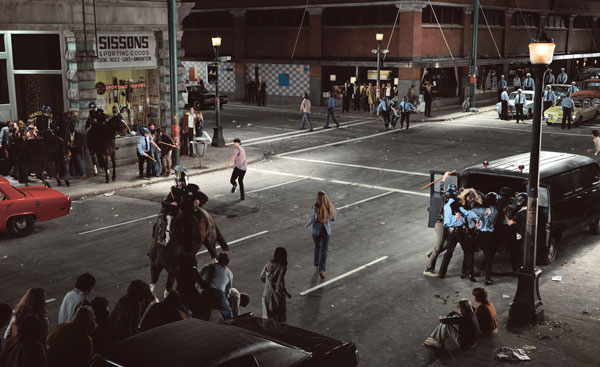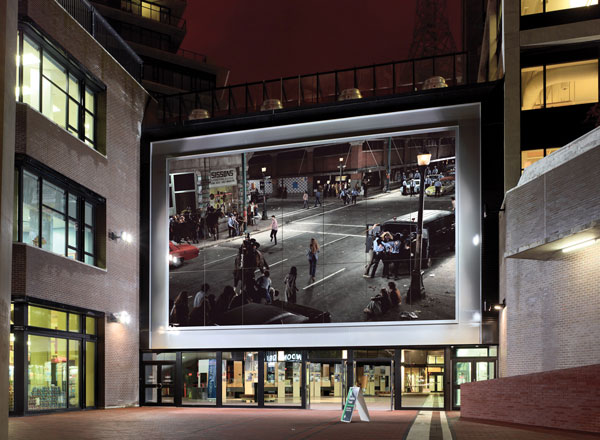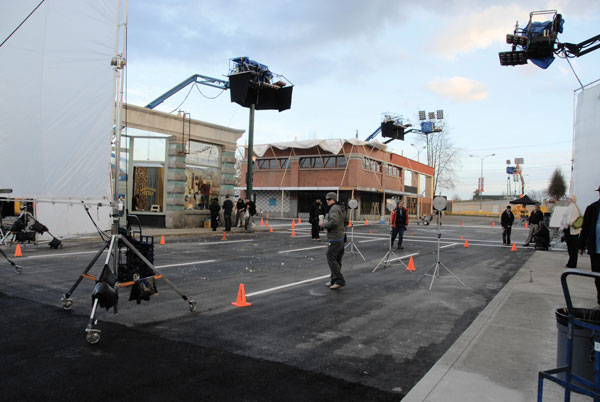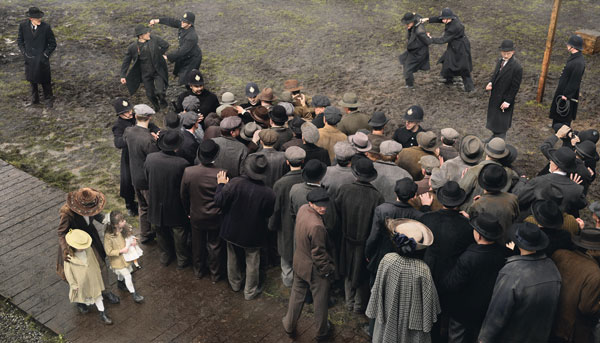[Summer 2010]
Abbott & Cordova, 7 August 1971 (2009) is an impressive piece of public art that addresses the very nature of public space. It is named after the two streets that cross at the north corner of the Woodward’s building, on which the artwork is installed. The image inhabits space like a sculpture, grandly overlooking the public and private courtyards of the new complex in Vancouver’s Downtown Eastside. It can be viewed from both sides; the front faces the public courtyard and the back is viewed from the private atrium, which is open to the public during store hours. The scale and situation of the work invoke the epic political murals of the early twentieth century, but, unlike these earlier works, it does not heroicize its subjects.
by Karen Henry
Abbott & Cordova, 7 August 1971 (2009) is an impressive piece of public art that addresses the very nature of public space. It is named after the two streets that cross at the north corner of the Woodward’s building, on which the artwork is installed. The image inhabits space like a sculpture, grandly overlooking the public and private courtyards of the new complex in Vancouver’s Downtown Eastside. It can be viewed from both sides; the front faces the public courtyard and the back is viewed from the private atrium, which is open to the public during store hours. The scale and situation of the work invoke the epic political murals of the early twentieth century, but, unlike these earlier works, it does not heroicize its subjects.
The image is constructed in a grid with sections that fit seamlessly together. Douglas experimented with a new technique – printing each section on 10 mm panes of tempered glass, then again in reverse on another sheet of glass, and fusing the two together with a semi-opaque vinyl diffusion layer sandwiched between. This gives the entire image an exceptional luminescent quality; the concentration of light provides depth and atmosphere. The technique is interesting in relation to the preponderance of the lightbox as a strategy for presenting photographs in public space and its historical relationship with art in Vancouver.
Brilliant and beautifully made, this is Douglas’s first public artwork, but it is one of a succession of major works throughout his career that engage with the geographic, racial, and economic complexities of Vancouver and the region, including Pursuit, Fear, Catastrophe: Ruskin, BC (1993), Nut•ka• (1996), Win, Place or Show (1998), and, most recently, Klatsassin (2006). Douglas has made a practice of combining singular events and styles of representation and bringing history into the present in unique ways.
Some background is useful in regard to the context of the artwork, which depicts a particular event in Vancouver history, popularly known as the Gastown Riot. Gastown is the historic heart of Vancouver, where the original city was established. The area is next to Chinatown and was traditionally home to labourers, longshoremen, and a concentration of Aboriginal people. In the late 1960s, a new element of transient youth began to congregate in the area and there were a number of encounters with the local authorities, culminating in a crackdown on the use of marijuana in 1971 resulting in 109 arrests in ten days. In the cavalier style of the day, a “Gastown Smoke-In and Street Jamboree” was organized at Maple Tree Square (about two blocks from the corner of Abbott and Cordova) to protest the police tactics and support the legalization of marijuana. Undercover police infiltrated the scene and raised fears of an armed confrontation. The riot squad was waiting and moved in, even though the rumoured weapons never materialized. Thus, the event was more about pre-emptive control than actual protest. By all accounts, the riot squad was quite brutal, and an inquiry was later established to look into the police behaviour. Michael Barnholden, in his history of riots in Vancouver, says that it was the end of innocence for the young people.1 This may be the most important specific association with Douglas’s image – it marked a pivotal point for young people in Vancouver, who now realized that the freedom to congregate could no longer be taken for granted.
Building on the association with the area where Woodward’s is located, Douglas has said he chose to depict this riot because he felt it was a turning point in the development of Gastown.2 It resulted in the city developing the area as a strictly commercial district – an extension of the hollowing out of inner cities that began in the 1950s with the development of suburban lands (coincidentally contributing to the alienation of the young people, who were now prohibited from reoccupying the area). In 1970, French intellectual Henri Lefebvre, writing about the organization of cities and suburbs as the core entrenchment of the social values of capitalism and class relations, stated that revolutionary change could come about only through a change in the way that urban space is structured.3 Working toward self-determination and fair social relations required a reconceptualization of the possibilities of urban life.
Gastown, in which economic activity was never robust but always vital, subsequently began to decline to its recent state as one of the poorest and most drug-ridden areas in North America. The closure of the Woodward’s family store in 1993 was key to this demise. The loss of the old-style department store, with a once-thriving food floor, impacted most local businesses in a downward cycle.
The building was vacant for over ten years, during which time neither the market nor the city could convince a developer to take it on. In 2002, the building was ringed by tents for three months as activists protested the homelessness problem in the area. It took a couple more years to cobble together a plan with the city, developers Westbank Projects/Peterson Investment Group, and other partners, for a project that would include market condominiums, affordable housing units, retail and office space, and the Simon Fraser University School for the Contemporary Arts. The building now houses an art gallery and a black-box theatre as well as major grocery and drugstore chains. In the context of the Vancouver Agreement, a revitalization plan involving all three levels of government, Woodward’s was seen as the flagship of a neighbourhood development plan committed to revitalization without displacement. Along the way, some ground was lost in terms of the number of (so-called) affordable housing units, and the neighbourhood has continued to wrestle with all levels of government regarding a commitment to housing and services, such as the Supervised Injection Site, that contribute to the health of the area. The opening of the Woodward’s building has already changed the area radically.
It remains to be seen whether it is the cornerstone for establishment of total gentrification or a burnished stone on the road toward a successful experiment in mixed economic communities.
This experiment to bring diverse socio-economic groups of people together is the other inspiration for Douglas’s piece4 and his depiction of a time when different groups clashed in the area. Local responses to the work are varied, effectively creating a dialogue about history, memory, control, and power, including the power of representation.
The image itself has a logic of triangulation – three corners, three streetlamps, three clusters of blue-shirted police and young people. In another version of this photograph, published in Walrus (Summer 2009), there are also three young people in the otherwise empty intersection. In the Woodward’s installation, the figure farthest into the intersection is not included due to the way the image is seamed,5 concentrating the gaze on the woman with the long red hair and the tense figure of the young man looking over his shoulder. (This look serves to position the site of the image in relation to the centre of the riot at Maple Tree Square, two blocks away.) The latter figure is further dramatized, as he is set against the bright glare of the street light. The absence of the third figure leaves the intersection itself completely open, hedged around by spectators and the blue-shirted police on foot and on horseback. The image depicts the more controlled edge of the riot area, as defined by the line of stopped traffic. The spectators include men in suits and others along the side of the Woodward’s building, a woman in a tan coat, a young couple on the corner, and, most intriguingly, two boys sitting passively on the curb in the lower part of the picture. One boy looks curiously at the scene while the other looks over his shoulder at the action farther down the street or at someone out of the frame. These boys are learning about the maintenance of civil order.
The mounted police are corralling people against the buildings and cars. Some of the young people may be undercover agents, as a couple of them hold police batons and appear to be assisting police. At face value, the image unavoidably represents authoritarian control of public space – a clearing-out of the centre. As such, despite the complexities and ironies of any given circumstance, it stands as a reminder of forces of power and prompts contemplation of civil rights and freedoms – a marker in relation to the current time of heightened surveillance and control. One is struck by how different the members of the riot squad look, in their blue shirts and helmets, from those of today, shielded in intimidating military gear. If a riot were to be depicted today, people would probably be writhing on the ground from the use of high-frequency sound, the latest in the arsenal of weapons at the disposal of police.
The empty centre of the photo also enhances the isolation of each distinct vignette – the individual stories within this larger confrontation. At approximately 9 x 15 metres, the image is cinematic in scale and construction. Douglas staged the entire scene in a parking lot and spent three days photographing, two with actors and one with the set itself. The image is a montage drawn from 50 views and 9 scenes written by the artist.6 While the brute force of the horses bearing down on the protesters is vicariously threatening, the strategy of multiple characters and poses inhibits total absorption in a singular totalizing image. This is in keeping with the artist’s self-conscious strategy of composition and with his previous programmed film works in which the narrative is combined and recombined in multiple variations.
Douglas staged four images of significant moments in Vancouver’s history related to civil order, in the series Humour, Irony and the Law – the title of a 1967 essay by Gilles Deleuze. Besides the depiction of the Gastown Riot, there is a work about a 1912 free speech demonstration, a confrontation between police and unemployed longshoremen at Ballantyne Pier in 1935, and a seemingly innocuous (though beautifully detailed) photograph of a crowd at the Hastings Racetrack in 1955. Douglas says that the last is a group of people “made into a body without their knowledge,”7 which implies the camera lens itself. In light of the historical specificity of the other photographs, I would guess that this alludes to a particular instance of surveillance.
In Deleuze’s essay, modern law is defined as a self-justifying force, pure power, pure form, and an elemental dynamic of human social organization. Irony and humour are the two modes of countering and subverting the law, encouraging the “perpetual motion and permanent revolution”8 of anarchy and ensuring the capacity for difference. Irony takes a position, outside of the struggle, in which absurdity becomes apparent. Another essay by Deleuze from the same period is a meditation on repetition as a site for producing difference – the difference between inside and outside, action and idea. Learning takes place in the encounter, in the dynamic space of difference between the sign and the response, where ideas and difference can manifest: “Repetition is a transgression. It puts law into question, it denounces its nominal or general character in favour of a more profound and more artistic reality.”9 Repetition acknowledges the original unique event as a sign, a site of theatre encompassing “the spiritual and natural powers that act beneath the words, gestures, characters and objects represented. They signify repetition as real movement, in opposition to representation which is a false movement of the abstract.”10 Douglas’s work reflects this idea in practice, as a specific sign, and also metaphorically in its construction – purposefully not one image to be viewed from two sides, but two images reproduced separately, with a dynamic space of light in between.
Many people are disturbed by the image, uneasy with the representation of police brutality or with remembering this specific event. The question lingers, how is this work positioned as public art in a commercial development ? Are its associations entirely co-opted by the new realities of public/private partnership – privately owned spaces that appear to be public, with agreements regarding access ? Developer Ian Gillespie is generally considered to be gutsy by his peers for displaying this artwork; or perhaps he is savvy; or possibly he, too, is caught up in the idealism of the rhetoric of change that surrounds the Woodward’s development. Is it the ultimate neo-liberal ability to absorb critique or an inkling of change in the way that cities are thought that begins to move beyond totalizing conceptions of capitalism and private property ?
Following Lefebvre’s line of thought, the construction of privatized public spaces is not encouraging, but activists living and working in this particular area have been instrumental in negotiating at least some affordable spaces for housing and arts organizations, and they continue to maintain pressure for a new kind of urban life. Douglas’s work broods over this contested terrain, a point of reference for the persistence and banality of the forces that maintain the status quo, literally and figuratively separating the private courtyard from the public plaza and positing that boundary as the site of conflict.
1 Michael Barnholden, Reading the Riot Act (Vancouver: Anvil Press, 2005), pp. 86–95.2 Kevin Griffin, “Gastown Riot Recreated in Contemporary Woodward’s Photograph,” Vancouver Sun, 6 January 2010.
3 David Harvey, “The Right to the City,” New Left Review 53 (September–October 2008), http://www.newleftreview.org/
?view=2740. See also Henri Lefebvre, The Urban Revolution (Minneapolis: University of Minnesota Press, 2003).
4 Robin Laurence, “The Battle of Gastown,” Georgia Straight, December 31, 2009.
5 E-mail correspondence with the artist, 9 February 2010.
6 Ibid.
7 Ibid.
8 Gilles Deleuze, “Humour, Irony and the Law,” reprinted in Scott Watson, Diana Thater, and Carol J. Glover, Stan Douglas (London: Phaidon Press Ltd, 1998), p. 84.
9 Gilles Deleuze, Difference and Repetition, translated by Paul Patton (New York: Columbia University Press, 1994) p. 3. See http://topologicalmedialab.net/xinwei/classes/readings/Deleuze/Difference-and-Repetition/English/DifferenceRepetition01.pdf
10 Ibid., p. 23.
Karen Henry is a curator, writer, and art consultant. She was formerly director of the Western Front in Vancouver, director/curator of the Burnaby Art Gallery, and adjunct curator for Presentation House Gallery, and she currently manages public art projects for city and corporate clients. She has published articles in Video Guide, Afterimage, Prefix, Blackflash, Parachute, and High Performance and in numerous art catalogues, including Acting the Part: Photography As Theatre (Ottawa: National Gallery of Canada, 2006).





